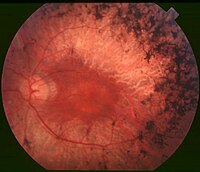
Photo from wikipedia
BACKGROUND Pathogenic variants in BEST1 can cause autosomal dominant or autosomal recessive dystrophy, typically associated with distinct retinal phenotypes. In heterozygous cases, the disorder is commonly characterized by yellow sub-macular… Click to show full abstract
BACKGROUND Pathogenic variants in BEST1 can cause autosomal dominant or autosomal recessive dystrophy, typically associated with distinct retinal phenotypes. In heterozygous cases, the disorder is commonly characterized by yellow sub-macular lesions in the early stages, known as Best vitelliform macular dystrophy (BVMD). Biallelic variants usually cause a more severe phenotype including diffuse retinal pigment epithelial irregularity and widespread generalized progressive retinopathy, known as autosomal recessive bestrophinopathy (ARB). This study describes three cases with clinical changes consistent with BVMD, however, unusually associated with autosomal recessive inheritance. MATERIALS AND METHODS Detailed ophthalmic workup included comprehensive ophthalmologic examination, multimodal retinal imaging, full-field and pattern electroretinography (ERG; PERG), and electrooculogram (EOG). Genetic analysis of probands and segregation testing and fundus examination of proband relatives was performed where possible. RESULTS Three unrelated cases presented with a clinical phenotype typical for BVMD and were found to have biallelic disease-causing variants in BEST1. PERG P50 and ERG were normal in all cases. The EOG was subnormal (probands 1 and 3) or normal/borderline (proband 2). Probands 1 and 2 were homozygous for the BEST1 missense variant c.139C>T, p.Arg47Cys, while proband 3 was homozygous for a deletion, c.536_538delACA, p.Asn179del. The parents of proband 1 were phenotypically normal. Parents of proband 1 and 2 were heterozygous for the same missense variant. CONCLUSIONS Individuals with biallelic variants in BEST1 can present with a phenotype indistinguishable from BVMD. The same clinical phenotype may not be evident in those harboring the same variants in the heterozygous state. This has implications for genetic counselling and prognosticationA.
Journal Title: Ophthalmic genetics
Year Published: 2023
Link to full text (if available)
Share on Social Media: Sign Up to like & get
recommendations!